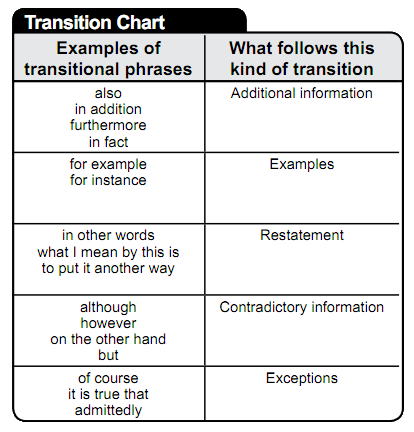Graphic Organizers for Revision
From your rough cut, you should move to a rough draft. In other words, you will write a full copy of your paper (although not yet in final form). After the rough draft, you will move to revision. The point of revision is not just to make things sound nicer (that’s fine to do, but not the main concern) but to clarify your meaning. Remember that in academic writing, the writer does all the work: no leaving anything to the reader’s imagination; no depending on the reader to infer a connection; and no worrying about boring the reader with helpful repetition.
So as you revise, you should try to think like a reader and constantly ask yourself, “Is this clear?” and “Could I make it more clear?”
To do this, keep a collection of transitional words and phrases handy and try to include them wherever you can. (It’s better to include too many than too few. As you reread what you have written, you will be able to cut the ones that are clearly unnecessary and intrusive.)
The chart that follows contains transitions from several categories. Use these phrases to make your writing clearer. You should also print this chart to help you with the next exercise. It’s a good idea to check off the phrases as you use them, so that you don’t repeat the same phrase—or use too many of the same kind of phrase.

You will discover that it is impossible to connect two sentences appropriately unless you know what both of them say. Below is a student’s paper that’s missing transitional phrases. Every time you come across a transition indicator ([transition]), read both the sentence before and the sentence after the transition marker, decide the relationship of the sentences, and choose a transition that will make that relationship clear to a reader. If you choose one from the correct grouping, you will receive a “Correct!” response. Otherwise you’ll be asked to try again.

